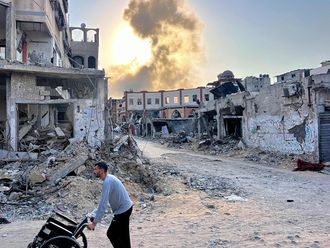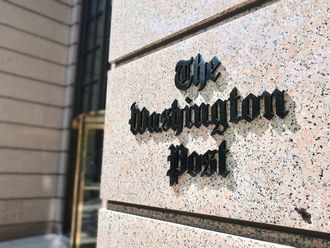In the grand narrative of the Second World War, the Battle of Bryansk is a minor conflict. But Bryansk has another place in history. It was there that a then-unknown tank commander named Mikhail Kalashnikov decided that his Russian comrades would never again be defeated. In the years following the Great Patriotic War, as Soviet propagandists dubbed it, he was to conceive and fabricate a weapon so simple, and yet so revolutionary, that it would change the way wars were fought and won. It was the AK-47 assault rifle.
The AK-47 has become the world's most prolific and effective combat weapon, a device so cheap and simple that it can be bought in many countries for less than the cost of a live chicken. Depicted on the flag and currency of several countries, waved by guerrillas and rebels everywhere, the AK is responsible for about a quarter-million deaths every year. It is the firearm of choice for at least 50 legitimate standing armies and countless fighting forces from Africa and the Middle East to Central America and Los Angeles. It has become a cultural icon, its signature form - that banana-shaped magazine - defining in our consciousness the contours of a deadly weapon.
Last week, the US military's presence in Iraq surpassed the length of time that American forces were engaged in the Second World War. And the AK-47 will forever link the two conflicts. The story of the gun itself, from inspiration in Bryansk to bloody insurgency in Iraq, is also the story of the transformation of modern warfare. The AK blew away old battlefield calculations of military superiority, of tactics and strategy, of who could be a soldier, of whose technology would triumph.
Ironically, the weapon that helped end the Second World War, the atomic bomb, paved the way for the rise of the lower-tech but deadlier AK-47. The A-bomb's guarantee of mass destruction compelled the two Cold War superpowers to wage proxy wars in poor countries, with ill-trained combatants exchanging fire - usually with cheap, lightweight and durable AKs.
When one war ended, arms brokers gathered up the AKs and sold them to fighters in the next hot spot. The weapon's spread helps explain why, since the Second World War, so many "small wars'' have lingered far beyond the months and years one might expect. For all of the billions of dollars Washington has spent on space-age weapons and military technology, the AK still remains the most devastating weapon on the planet, transforming conflicts from Vietnam to Afghanistan to Iraq. With these assault rifles, well-armed fighters can dominate a country, terrorise citizens, grab the spoils and even keep superpowers at bay.
In late September 1941, the German juggernaut reached the outskirts of Bryansk, hard against the Desna River southwest of Moscow. In the battle, the Nazis destroyed about 80 per cent of the town and killed more than 80,000 people. Kalashnikov, who was 21, was wounded but made it to a hospital on foot. He suffered nightmares about the Germans slaughtering his comrades.
Obsessed
Kalashnikov became obsessed with creating a submachine gun that would drive the Germans from his homeland. In his hospital bed, he sketched out the simplest automatic weapon possible. His obsession led him to a metal shop, where he developed a prototype submachine gun; later to a technical school, where he invented a carbine; and finally, to the creation of the Avtomat Kalashnikova 1947 (AK-47), approved for production that year. It combined the best characteristics of a submachine gun (light weight and durability) and a machine gun (killing power). By the end of 1949, arms plants had turned out about 80,000 AKs.
Although the AK came too late to see action in the Second World War, the Soviets knew their assault rifle could become the most important weapon of the modern era and they worked hard to keep it hidden from the West. Soviet soldiers carried their AKs in special pouches that disguised their shape; they picked up spent cartridges to keep the newly sized ammunition a secret.
The 1956 uprising in Hungary compelled Soviet leader Nikita Khrushchev to dispatch the Red Army to Budapest. The episode required the first large-scale public use of the AK and it performed well in an urban environment where tanks became bogged down in narrow streets against crowds wielding Molotov cocktails.
By the late 1950s, the Soviet Union had begun using the AK to spread communism. The Soviets also distributed free licences to produce the AK-47 to "fraternal countries", including Bulgaria, China, East Germany, Hungary, North Korea, Poland and Yugoslavia.
It was not until the Vietnam War - the first major proxy battle against the Soviets - that US troops faced the AK-47 in action. They would pay dearly for their government's failure to recognise the power of Kalashnikov's simple weapon.
For all their military might, US forces in Vietnam did not have an infantry weapon that could stand up to the AK in the pattern of warfare that was emerging. After many years of bureaucratic wrangling, the US military had finally introduced its own assault rifle, the sleek and sophisticated M-16. More than 100,000 of them were ordered by the summer of 1966 and shipped to the Asian war zone. By October, however, some unexpected reports were coming in. M-16s were jamming in combat.
The AK came to be perceived widely as the world's top infantry weapon and one that could beat the West's best offering. It was low-tech Soviet style vs high-tech American style, and the communists won the war of perception.
If the Vietnam War gave the AK its credibility, it was the Soviet war in Afghanistan and the subsequent demise of the Soviet empire that accelerated the weapon's dissemination, placing it in the hands of insurgents and terrorists who embraced it as an icon of anti-imperialism.
When the last Soviet troops left Afghanistan on February 15, 1989, the vast arms infrastructure did not disappear. It had become ingrained in the economy and culture of Afghanistan and neighbouring countries.
International reach
The AK's international reach expanded further as the USSR collapsed and former Soviet bloc countries auctioned off their arms stockpiles. AKs began selling for bargain-basement prices throughout Africa, where countries were fragmented into tribal groups with long-standing ethnic resentments. In Liberia, Rwanda, Sierra Leone, Somalia and elsewhere, AKs prolonged small conflicts that previously would have petered out.
In Latin America, AKs ended up in the hands of drug cartels and anti-government rebels. In the mountainous border area near Pakistan, Saudi-born millionaire Osama Bin Laden, in several videotapes warning the West about reprisals, is seen with an AK either next to him or propped up in the background.
The AK is also the weapon of choice in the latest "small war'' that a superpower believed would be brief and painless: Iraq. When the Coalition Provisional Authority (CPA) was planning to outfit Iraqi forces, they were surprised to find that the Iraqis insisted on AKs.
Now 85, feeble, nearly deaf, his right hand losing control because of tremors, Kalashnikov is often haunted by the killing machine he has bestowed upon the world. "I wish I had invented a lawnmower,'' he told the Guardian in 2002.
"I invented it for protection of the motherland,'' Kalashnikov told an interviewer. "I have no regrets and bear no responsibility for how politicians have used it.''
Larry Kahaner is the author of 'AK-47: The Weapon That Changed the Face of War'.








